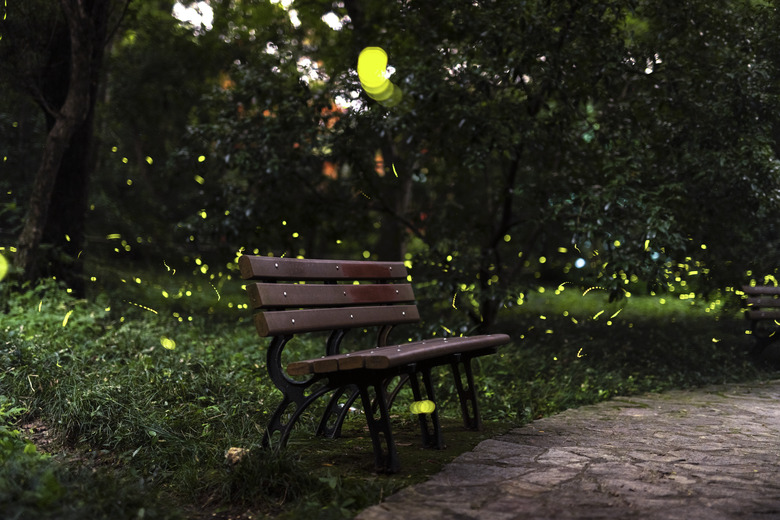How Long Does A Firefly Live?
Fireflies, also known as lightning bugs, are not actually flies. The insect commonly called a firefly belongs to the Lampyridae family of beetles.
Most insects in North America have a short lifespan, often surviving only one season. The adult firefly is no exception, but it does take some time for it to reach the adult stage.
TL;DR (Too Long; Didn't Read)
Fireflies live for only a couple of months, but it takes up to a year for the insect to fully grow into the short-lived adult.
Firefly Life Cycle
Firefly Life Cycle
Fireflies grow by a four-stage process called _complete metamorphosis_. After mating, female fireflies lay their eggs on the ground or under mulch or logs in mid-summer. Eggs incubate for approximately three weeks before they hatch into larvae.
Firefly larvae are elongated, flattened and wingless with distinct, usually dark-colored segments on the top and a lighter color underneath. At the larval stage, and in some species even the egg stage, the firefly is luminescent; that is, it produces light.
These larvae live under bark, in the ground or in other moist habitats. They are carnivorous, feeding on small creatures like snails, spiders and other insects. Larvae spend the winter in their protected habitats before pupating in early to late spring.
During the pupal or resting stage of development, the firefly larva forms a hard casing on the outside and remains immobile for a few weeks. It may not appear to be moving at this stage, but there are many changes happening. The firefly's wings are developing, and the insect is growing into its adult form.
Adult Fireflies
Adult Fireflies
The fully formed adult that we might recognize by its flashing-light behavior emerges from the pupa in early to mid-summer. Adult fireflies are approximately half an inch long with brownish hard wing casings called elytra. The elytra often have yellow edges, and the insect can have yellow or orange markings.
The light-emitting part of the firefly is at the end of its abdomen. As an adult, the firefly's main goal is to find a mate and reproduce. Using their luminescent quality, males and females flash light signals to find each other.
Firefly Lifespan
Firefly Lifespan
Fireflies only live a couple of weeks as adults. But, accounting for each stage of development from egg to adult, fireflies typically live for about a year. Throughout that time, they are only capable of flying and laying eggs for approximately two months.
With about 2,000 species of firefly worldwide, there will, naturally, be some variability in their lifespan. Some species can remain in the larval stage for up to two years and their luminescence keeps them safe over that time.
Bioluminescence
Bioluminescence
A firefly's ability to emit bioluminescent light is made possible by the enzyme luciferase. Chemical reactions in the body, when oxygen combines with calcium and other elements, produce light. Much like glow-in-the dark toys or glow-sticks, the light does not produce heat as a light bulb would.
While the light in adult fireflies helps to attract mates, in the larval stage, the light also acts as a warning to predators. Firefly larvae produce a defensive chemical that is distasteful to predators. The light warns other creatures to avoid eating the larvae.
Glow Worms
Glow Worms
Glow worm is a term often used to describe the larvae of fireflies, but the term actually refers to a separate family of beetles called Phengodidae. This uncommon group of beetles have similar habitats and behaviors to fireflies, but it is only the female and larva that are luminescent.
The term glow worm is also used to describe a group of flies known as fungus gnats, some of which are bioluminescent.
References
- Firefly Conservation and Research: Facts About Fireflies
- Texas A&M AgriLife Extension: Field Guide to Common Texas Insects: Firefly
- Iowa State University Extension and Outreach: Horticulture and Home Pest News: Lightningbugs
- Cornell University's Naturalist Outreach: Everything Is Illuminated: A Guide to Fireflies and Bioluminescence
- Wet Tropics Management Authority: Glow Worms and Fireflies
Cite This Article
MLA
Godawa, Jean. "How Long Does A Firefly Live?" sciencing.com, https://www.sciencing.com/long-firefly-live-8687259/. 22 November 2019.
APA
Godawa, Jean. (2019, November 22). How Long Does A Firefly Live?. sciencing.com. Retrieved from https://www.sciencing.com/long-firefly-live-8687259/
Chicago
Godawa, Jean. How Long Does A Firefly Live? last modified March 24, 2022. https://www.sciencing.com/long-firefly-live-8687259/
